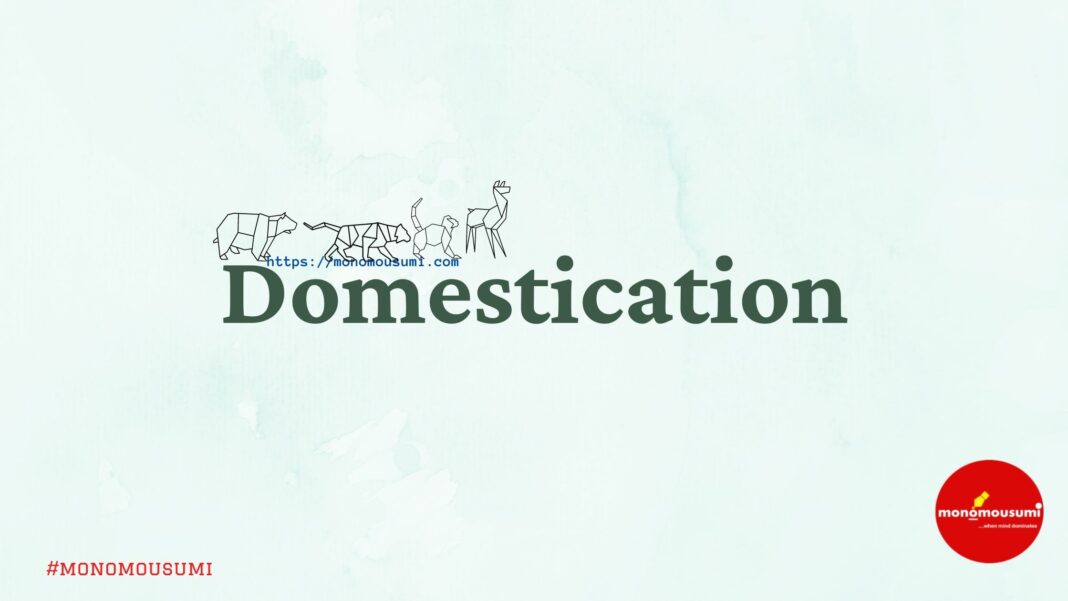Writing Patents was a very important invention. Patents are really what make ‘invention’ an invention. We know Edison ‘invented’ light bulbs, because he holds a Patent No. 223.898 in the USA. Similarly, we know silicon chips were discovered by Jack Kilby and Robert Noyce independently, but Robert Noyce holds the patent because his patent application was neat and elaborate unlike Jack Kilby’s historical ‘flying wires’ diagrams. This patent rivalry could make a different story on its own but this isn’t really what we are interested in.Today when things like patents, copyrights exist, the claim over ‘inventions’ is still a tough nut to crack. But plenty of things were invented before a system of patents existed. ‘Domestication’ is one such groundbreaking invention, which nobody knows who, when, how, why and where, invented.
The historians typically classify pre-history(non-written history) into four periods-paleolithic, mesolithic, neolithic and chalcolithic. Paleolithic is a period when the main source of food was obtained by hunting and gathering. Tools of this period were made up of core and flakes. The following period i.e. mesolithic, differed from palaeolithic in the type of tools used. Microliths(a comparatively small sized tool with handles) were the main tools used. Also, domestication of animals started in this period. And then followed the neolithic, in which tools were grounded and polished and domestication of plants as well as animals started. Chalcolithic was obviously a period when tools made of copper started flourishing. Neolithic period forms the basis of this essay as the invention of ‘domestication of plants and animals’ or ‘agriculture’ forms the subject matter.
Life Before Domestication.
Before getting into the life before domestication, it is necessary to differentiate between collection/keeping and domestication. When grain is harvested and consumed, it is a stage of collection while when the harvested grain is consumed and some part is left intentionally to be planted later, this is termed as plant domestication. Similarly when an animal is captured and kept, this is animal keeping, while when same animals are kept away from their natural habitat and bred under artificial conditions for human profits,this is termed as animal domestication.
Start of domestication is such an old invention that we can hardly talk concrete on anything related to it. All the theories are based on various archaeological evidence and inferences drawn from them by the historians. Homo sapiens(human) till the advent of agriculture were nomadic creatures wandering from place to place in search of food and resources. Changes in weather, availability of food etc. affected their stay at a particular place and that’s the reason why permanent structures or settlements hardly existed at that time. The first ever archaeological evidence of domestication in sub-continent was found at Mehrgarh, Baluchistan in Pakistan. Domestication of animal did happen previously but the word domestication, in a broader sense, here includes domestication of animals as well as plants.Common domesticated plants were wheat and barley, while goats, sheeps and cattle were preferred as animals.It is believed or had been inferred that domestication for the first time, ever in the world, started somewhere in West Asia.
Why Domestication?
Did the people get bored of hunting and collecting and of their lives as nomadic creatures or something else contributed to their shift to domestication? Was it an accidental experiment? There can be multiple possible answers to these questions. As domestication started independently in various parts of the world spanning for hundred of years, the reasons to shift to domestication are plenty.
( Burnt Rice Husk at a Neolithic Site )
It was initially argued that due to the northward shift of summer monsoon, the place(West Asia) became drier and people started to shift near the rivers and other water sources. The close association of plants, animals and human beings near these resources lead to domestication. However, this argument is countered by many with the demographic factors. They argue that increase in population due to internal stress(increase in population within community) and external stress(increase in population due to migrations) altered the population-resource ratio and hence people shifted to new technologies and alternatives. The point which gives strength to the later argument is that various hypothesis have concluded that people shift to alternate sources of food only when the population-resource ratio is unbalanced. It may also be possible that this started just as an accidental experiment. Whatever the reason may be, domestication has changed the way people live.
Initial techniques of agriculture.
A natural ally to human beings, i.e. fire, is also the most ancient tool used in agriculture. To clear the lands to be used for agriculture, to prevent disease and pests and to control the growth of plants, people used fire. However, this doesn’t continue for long. Stone tools such as diggers(stick), axes were used for agriculture later to chop trees and till the soil and irrigation facilities were made possible by cutting down streams of rivers directly into their farming lands, a technique which continued for many ages to come. Later the stone tools were replaced by metal tools like handaxes, sickle, plough etc. in the copper and iron ages.From then on, agricultural methods, tools, irrigation facilities have continuously improved over time.
( Initial tools for agriculture )
The first domesticated animals included pigs, goats, sheep, cattle, buffalo and yaks. The domesticated animals were fed properly and an artificial habitat was ensured for their growth. The shed for animals was usually kept near the houses and sometimes sheds were found inside the houses too. The domesticated animals provided various help to the ‘budding’ farmers. They helped the farmers do more physically laborious work and at the same time providing wool for textiles, milk and meat for consumption and as carriers for heavy materials.The parallel development of animal domestication helped agriculture a lot. The impact of domestication has been huge and can be seen in generations that followed.
Impacts of Domestication.
- Pottery: With the advances in agriculture and the yields produced, part of the yield left required storage facilities. Initially, pots may have been used for water storage but pastoralists humans hardly stayed at a place for long, so its application may have been limited. While with the invention of agriculture, grains harvested required proper storage facilities which were provided by pottery. Cooking utensils were also required for cooking purposes which also gave the boost to pottery. Storage pots, cooking utensils are found at most neolithic sites which shows the parallel development of pottery with agriculture.
- Sedentariness: This is one of the most obvious developments that occured due to agriculture. Agriculture with no doubt gave rise to communities which later transformed into civilisations. With the advent of agriculture, nomadic life did not stop altogether. It may have been carried for centuries, even within farming communities, but in the long run the transition to agriculture did lead to increasing levels of sedentariness among communities, which later gave rise to civilisations and then to urban cities.
- Biological impacts: There have been many biological impacts on human beings over the generations due to agriculture. The population-agriculture is a popular cause and effect story. Both are the causes and effects of each other. A shift to carbohydrate-rich diet from a protein-rich diet has reduced the birth intervals and has led to an increase in population. A sedentary living also meant more stable conditions for a pregnant woman to live in, contributing to the higher birth rate. The reduced average height over generation, lesser bone density, a high calorie diet, are also said to be the impacts of agriculture. Domestication of animals has led to closer association of humans with animals, leading to the spread of various diseases in the human population.
- Technological Impacts: Agriculture, overtime, required more technical requirements which were fulfilled by further inventions. For the better irrigation facilities, initially wells and then dams were constructed which are considered to be modern temples of humankind. Better tools for tilling, harvesting, threshing were developed. The invention of vaccination by Edward Jenner also traces roots to domestication of animals. Domestication led to civilisations, which led to technological advances in making houses and permanent structures for storage. Many more technological advances could be traced back to domestication.
The advent of domestication is such an important part of human evolution that it is very important to acknowledge it. It marks a point from where an exponential development took place in human life. Getting into the discussion of who and when started domestication is not mandatory, but to acknowledge its importance in the contemporary world is much more important. According to ILO, out of 1.1 billion people engaged in agriculture, many millions of them are earning below the subsistence level. In India,average monthly income per agricultural household is less than Rs. 6500. When every sector was locked down in the current COVID crisis, it was the agricultural sector that kept working. Many inventions have changed human life for the better, but domestication changed the course of humanity. No matter we do not know who ‘exactly’ started it, when it ‘exactly’ started, where it ‘exactly’ started but the crux is we know ‘exactly’ what importance it holds in our contemporary lives. ‘Agriculturist’, who could be said as the second major ‘inventors'(after fire), are today the lowest paid workers in the world. It is time that we work towards returning the dignity of our early inventors and overcome the challenges they face today. Only then, the ‘invention’ of domestication will be duly rewarded and honoured.
By Aman Srivastava










